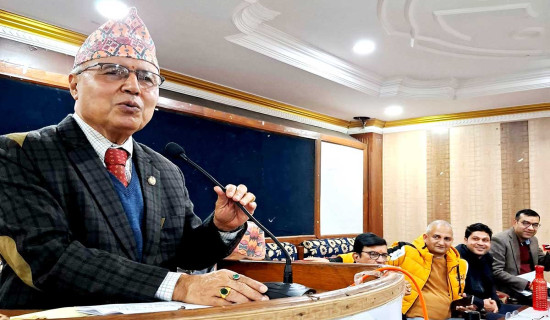- Sunday, 7 December 2025
Lessons From Disaster
The country is still struggling to pick up the pieces after the monsoon rain-induced floods and landslides left a trail of death and destruction last week. In the hindsight, it has become clear that the country was not prepared to tackle the natural calamity of this magnitude. The disasters like floods, landslides, tornadoes and earthquakes are unpredictable. They usually catch the people on the hop. However, with the development of sophisticated technology, much has been attained in forecasting the weather events such as rains and hurricanes. In Nepal too, experts at the Hydrological and Meteorological Department have been successful in making accurate or near- accurate prediction about the rains. They had also made warning about the recent downpours that lashed central and eastern Nepal. Although there could be a precise prediction of rains, it is difficult to foretell about the floods and landslides that happen as a result of cloudbursts and downpours.
The country suffered a huge loss in terms of human casualties and destruction of infrastructure such as roads, bridges, hydropower plants and private houses, among others. Questions have also been raised regarding the effectiveness of coordination among the relevant agencies and flow of information about the warning of rains on September 27 and 28. The authorities had apparently failed to convey the department's message to the travellers about the potential danger that the incessant rains could bring to them when they travel during that time. If the vehicles had been prohibited from operating at nights when there were heavy rains, 35 passengers would not have been buried at Jhyaple Khola landslides in Dhading. Those, who chose to travel to the rain-affected areas, had either taken the warning for granted or were not fully informed about this.
According to the latest data of the Home Ministry, as many as 228 people have died, 25 are still missing and 158 have sustained injuries in the floods and landslides. The security personnel have rescued more than 4300 people from the flood-affected areas. It is estimated that the disaster incurred damages worth around Rs 17 billion. Around 21 districts including Kavrepalanchok, Lalitpur, Dhading, Kathmandu, Sindhupalchok, Sindhuli, and Makwanpur saw large number of deaths and massive damage of properties. The government has left no stone unturned in mobilising the search and rescue operation teams, and distributing the relief assistance to the disaster victims. The affected people have received food and medical treatment free of cost.
Prime Minister KP Sharma Oli has called on all Nepalis to come together in the moment of grief and show resilience to deal with the natural devastation. Speaking at a press conference at his office at Singha Durbar the other day, the Prime Minister reiterated the government's unwavering commitment to support those affected, and shed light on the extensive measures in regard to relief, search and rescue operations. This is time to show solidarity so as to fight the calamity effectively. It is not time to politicise the matter as such activity will add insult to the injury to the disaster victims. The government has admitted shortcomings in its response to the calamity. PM Oli noted that the lessons learned from this catastrophe would be instrumental in guiding future improvements in infrastructure and preparedness. The concerned authorities and all stakeholders must be aware of this matter and stay ready to face the challenges posed by the unanticipated natural disasters.

















